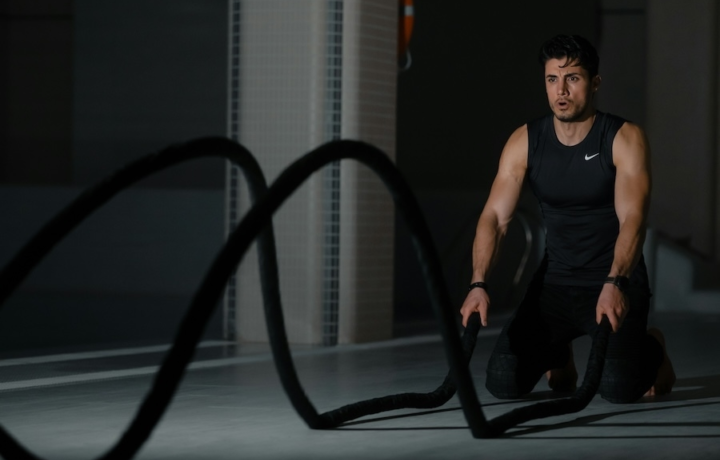Exercise
Renegade Row

Renegade Row
How to Perform
- Assume a push-up position with feet hip-width apart, placing your hands on two dumbbells positioned directly under your shoulders.
- Engage your core and squeeze your glutes to maintain a straight line from your head to your heels, ensuring your hips don't sag or pike up.
- Shift your weight slightly to your left side while maintaining your plank position, keeping your body as stable as possible throughout the movement.
- Row the right dumbbell up toward your hip, keeping your elbow close to your body and your wrist straight throughout the movement.
- At the top of the movement, squeeze your right shoulder blade toward your spine, maintaining tension in your back muscles.
- Lower the dumbbell back to the floor with control, fully extending your arm without allowing your torso to rotate.
- Shift your weight to the right side and repeat the rowing motion with your left arm, maintaining the same rigid plank position.
- Continue alternating sides for the desired number of repetitions, exhaling as you pull the weight up and inhaling as you lower it down.
Important information
- Keep your hips and shoulders square to the floor throughout the exercise, resisting the urge to rotate your torso as you lift.
- If you feel strain in your lower back, widen your stance or use lighter weights until your core strength improves.
- Focus on pulling with your back muscles rather than your arms by initiating the movement from your shoulder blade.
- Maintain a neutral neck position by looking at a spot on the floor about a foot in front of you rather than looking up or down.

Renegade Row
Exercise Details
Primary Muscles
Muscle Groups
Mechanic
Risk Areas
Built for progress
Take the guesswork out of training
Create personalized AI-powered workout plans that evolve with you. Train smarter, track every rep and keep moving forward, one workout at a time.






The Renegade Row stands as a formidable compound exercise in the fitness world, challenging even intermediate athletes with its unique blend of anti-rotation stability and unilateral pulling power. This dynamic movement simultaneously engages multiple muscle groups, with primary activation in the latissimus dorsi (lats), while significantly recruiting the triceps and anterior deltoids (front delts) as crucial supporting players in the movement pattern. What makes the Renegade Row particularly valuable is its versatility across training methodologies. In HIIT protocols, it elevates heart rate while building functional strength; within CrossFit WODs, it tests core stability under fatigue; and in bodybuilding regimens, it sculpts definition across the back while enhancing upper body symmetry. This adaptability makes it a premium selection for anyone looking to maximize training efficiency.
The exercise's true benefit lies in its comprehensive strength development. Beyond the obvious back and arm work, the plank position foundation creates tremendous core engagement, essentially turning your midsection into an isometric powerhouse that must resist rotation with each repetition. This anti-rotation component trains the body for real-world strength that translates to improved performance in daily activities and athletic endeavors alike. Research suggests that unilateral exercises like the Renegade Row address muscle imbalances more effectively than their bilateral counterparts, potentially reducing injury risk while optimizing functional strength development.
The exercise's ability to simultaneously challenge stability and strength makes it particularly effective for developing the kind of practical, usable power that serves athletes across disciplines. For those seeking to break through training plateaus, the Renegade Row offers that perfect combination of challenge and reward. Its compound nature triggers substantial hormonal responses favorable to muscle development, while its stability demands enhance neuromuscular efficiency: essentially teaching your body to recruit more muscle fibers more effectively during all pulling movements.
FAQ - Renegade Row
The Renegade Row primarily targets your latissimus dorsi (lats) while significantly engaging your triceps and anterior deltoids. Your core muscles work isometrically throughout the movement as they resist rotation, making this a true full-body compound exercise.
Beginners can perform the exercise with knees on the ground or using elevated handles for stability. To increase difficulty, advanced lifters can add weight, increase time under tension, or elevate feet on an unstable surface like a BOSU ball.
The three most common errors are rotating the hips during the row, allowing the lower back to sag, and using momentum instead of controlled pulling. Focus on keeping your body parallel to the floor with hips square throughout the entire movement.
For optimal results, incorporate Renegade Rows 1-2 times weekly, typically on upper body or full-body training days. Allow 48-72 hours between sessions that include this exercise to ensure proper recovery of the working muscles.
While Renegade Rows can strengthen core stabilizers that support the lower back, those with existing back conditions should start with modified versions and focus on perfect form. Consider consulting a physical therapist before adding this exercise if you have chronic back pain or injuries.








